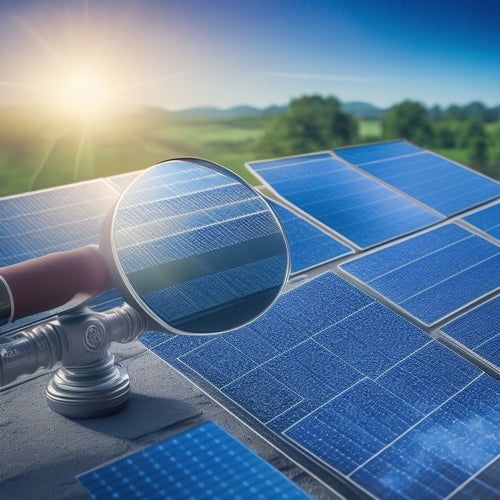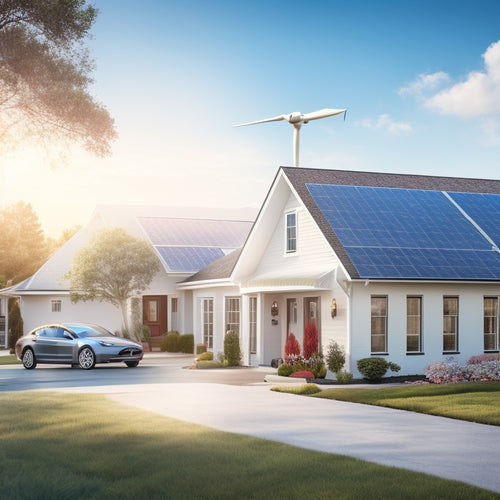
3 Essential Steps for a Successful Solar Panel Installation
Share
You'll want to start by evaluating your solar readiness, determining your site's suitability for solar panels, and analyzing your energy consumption patterns. This step helps you identify potential energy-efficient upgrades and guarantee a successful installation. Next, you'll need to choose the right equipment, selecting solar panels, inverters, mounting systems, and monitoring controls that fit your needs. Finally, confirm proper installation by conducting thorough site evaluations, obtaining necessary permits, and following industry standards and best practices. By following these three essential steps, you'll be well on your way to a successful solar panel installation that meets your energy goals - and that's just the beginning.
Key Takeaways
- Assess site suitability for solar panels, considering shade, roof direction, and roofing material to ensure optimal energy production.
- Choose the right equipment, including solar panels, inverters, mounting systems, and monitoring solutions, based on efficiency, durability, and cost.
- Ensure proper installation by conducting thorough site evaluations, obtaining necessary permits, and following industry standards and best practices.
- Conduct thorough testing and inspection of the solar panel system post-installation to ensure optimal performance and identify potential issues.
- Analyze past utility bills to determine energy consumption patterns and identify potential energy-efficient upgrades to maximize ROI.
Assess Your Solar Readiness
Before diving into the installation process, it's essential to evaluate your solar readiness, taking into account factors that will greatly impact the effectiveness of your solar panel system.
You'll want to assess your site to guarantee it's suitable for solar panels. This involves evaluating the amount of shade your roof receives, the direction it faces, and the type of roofing material. A south-facing roof with little to no shade is ideal.
Next, you'll need to determine your energy consumption patterns. Take a close look at your past utility bills to understand your energy usage. This will help you determine the size of the solar panel system you need to meet your energy demands.
You may also want to think about any energy-efficient upgrades you can make to reduce your energy consumption. By understanding your energy needs, you can optimize your solar panel system to maximize energy production.
A thorough site evaluation and understanding of your energy consumption will guarantee a successful solar panel installation that meets your needs and provides a strong return on investment.
Choose the Right Equipment
With your solar readiness assessment complete, you're now ready to select the right equipment for your solar panel system. This is a critical step, as the type and quality of equipment you choose will directly impact the performance and efficiency of your solar panel system.
When it comes to choosing the right equipment, reflect on the following key components:
-
Solar panel types: Monocrystalline, polycrystalline, and thin-film solar panels each have their own advantages and disadvantages. Contemplate factors like efficiency, durability, and cost when selecting the right type for your system.
-
Inverter options: String inverters, microinverters, and power optimizers are just a few of the inverter options available. Think about the size of your system, the type of panels you're using, and the level of monitoring and control you need when selecting an inverter.
-
Mounting systems: Roof-mounted, ground-mounted, and tracking systems are all options to reflect on. Take into account the size and layout of your solar panel array, as well as the type of roof or surface you're installing on.
-
Monitoring and control systems: Consider the level of monitoring and control you need, from simple monitoring of energy output to advanced data analytics and system optimization.
-
Battery backup options: If you're reflecting on energy storage, think about the type and size of battery you need, as well as the charging and discharging parameters.
Ensure Proper Installation
Your solar panel system's performance and longevity depend on a precise and skilled installation. You've chosen the right equipment, now it's time to guarantee it's installed correctly. A thorough site evaluation is vital to identify potential obstacles, such as shading, structural integrity, and electrical connections. This assessment will help your installer determine the ideal system design and configuration for your property.
Next, obtain all necessary installation permits from local authorities. This may include electrical and building permits, as well as compliance with local zoning laws. Failing to secure these permits can result in costly delays, fines, or even system removal. Your installer should handle the permitting process, but it's important you understand the requirements and timeline.
During the installation process, make certain your installer follows industry standards and best practices. This includes proper mounting, wiring, and connection of the solar panels, as well as thorough testing and inspection of the system.
Frequently Asked Questions
What Maintenance Is Required for Solar Panels?
You'll want to prioritize solar panel cleaning every 6-12 months to guarantee peak energy output, and regularly monitor performance to detect potential issues, allowing you to take prompt action and maximize your system's efficiency.
How Long Do Solar Panels Last on Average?
You'll be thrilled to know that solar panels can last an astonishing 50 years or more, with the average lifespan being around 30 years, depending on durability factors, making them a sound investment for your energy independence.
Can I Install Solar Panels on a Metal Roof?
You can install solar panels on a metal roof, leveraging its benefits like added durability and water-tightness, but be prepared to tackle unique installation challenges like specialized mounting systems and ensuring secure fastening.
Will Solar Panels Increase My Property Value?
As you consider utilizing the sun's energy, you'll be delighted to know that installing solar panels will likely enhance your property value, thanks to solar incentives and a potential increase in your property appraisal, making your home a coveted gem in the neighborhood.
Can I Sell Excess Energy Back to the Grid?
You'll be thrilled to know you can sell excess energy back to the grid through net metering options, allowing you to offset your energy costs, and some utilities even offer energy buyback programs, giving you credits or cash for your surplus energy.
Conclusion
As you flip the switch, the panels spring to life, utilizing the sun's warm rays to power your home. With these three essential steps - evaluating your solar readiness, choosing the right equipment, and ensuring proper installation - you've paved the way for a seamless shift to renewable energy. Now, imagine the satisfying hum of your system, quietly generating clean energy while you reap the financial rewards and bask in the glow of a sustainable future.
Related Posts
-

Why You Need a Phone Mount for Navigation
When you're on the road, a reliable phone mount is not just a convenience, it's a safety necessity that helps you mai...
-

Solar Panel System Certification Costs: A 10-Point Breakdown
You're looking to understand the costs associated with solar panel system certification. Your total certification cos...
-

Why Homeowners Are Embracing DIY Energy Independence
By taking control of your energy needs, you're breaking free from the uncertainty of utility bills and embracing a se...


